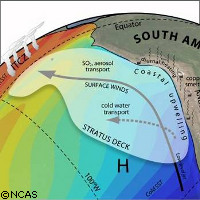Do clouds affect climate and weather?
Scientists from the National Centre for Atmospheric Science in the UK travelled to Chile to determine how huge swathes of cloud hanging over the southeast Pacific are impacting climate and weather on Earth. The team believed their work would help correct a number of errors found in the climate models used today. The findings will make it easier for scientists to predict future climate change, they said. The clouds studied by the scientists are known as marine stratocumulus clouds, which typically form next to continents where deep, cold, upwelling water reaches the sea surface, the team said in a statement. The surface air is cooled, triggering condensation and cloud formation. The warm air that descends into the region coats these clouds, they added. At times bigger than the size of the US, these clouds could impact the global climate because they act like a mirror, reflecting sunlight back into space and reducing the amount of energy that reaches the planet's surface, the team underlined. These clouds also maintain the cool temperatures of the ocean beneath them. The effects can have unplanned consequences for global weather and can affect how much heat is transported to the region in question. Over the course of the month-long study, the scientists sought to unlock the mystery behind why and how these clouds form. The information would help the team give a more accurate representation of these clouds in global climate models. 'These are some of the largest cloud systems in the world and we know they must play a very significant role in climate change, yet we know that climate models do not represent them very well,' Professor Hugh Coe from the National Centre for Atmosphere Science explained. 'This campaign is a fantastic opportunity to make cutting-edge measurements in a unique environment and merge them with state-of-the-art climate models,' the lead scientist added. 'By working closely with the Met Office and international colleagues in this way, we hope to finally hit some of the uncertainties in current climate models on the head.' By using the latest cloud and dust probes fitted to two UK research aircraft to gather information about the clouds' properties, the scientists were able to shed light on the formation of clouds, how reflective they are and how long they last. The team also aimed to determine whether man-made pollution, owing to the mining activities along the Chilean and Peruvian coasts, have an impact on the changing clouds' properties. The British project is part of the international programme 'VOCALS' ('VAMOS ocean cloud atmosphere land study) that is investigating the complex responses between clouds, ocean and land, and how these impact the global climate. The scientists remarked that physicists and climate modellers would benefit from the results of the study, as they would be able to improve their quantitative understanding of clouds. The results will also give British climate specialists the means to use high-resolution climate models to analyse the interactions between the ocean, atmosphere and the Andes, and determine how they affect the climate of the region and the world.
Countries
United Kingdom



